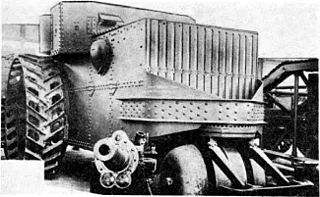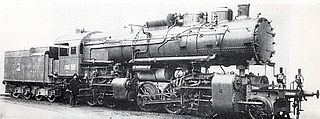
A steam tricycle is a steam-driven three-wheeled vehicle.

A steam tricycle is a steam-driven three-wheeled vehicle.
In the early days of motorised vehicle development, a number of experimenters built steam-powered vehicles with three wheels. The first steam tricycle – and probably the first true self-propelled land vehicle – was Nicolas-Joseph Cugnot's 1769 Fardier à vapeur (steam dray), a three-wheeled machine with a top speed of around 3 km/h (2 mph) originally designed for hauling artillery. Failing to meet the army's design criteria, no further development was undertaken.
The Long steam tricycle appears to be one of the earliest preserved examples, built by George A. Long around 1880 and patented some time around 1882; an example is on display at the Smithsonian Institution. [1]
In 1881 the Parkyns-Bateman steam tricycle was demonstrated in England. It used a petroleum-fired steam boiler (making it the first petroleum-powered vehicle), driving a double-acting two cylinder steam engine on the chassis of a Cheylesmore tricycle. Although numerous orders were reportedly placed, British law made such vehicles essentially illegal on the public roads. An example was displayed in the Science Museum from 1912 to 1922.
A small steam tricycle was built by Albert, Comte de Dion in 1887. This had two wheels in the front, between which was mounted the boiler, and a single rear wheel driven by the engine. It was fitted with pneumatic tyres.[ citation needed ]

In the same year Léon Serpollet also constructed a coal-fired steam tricycle, with the "steam generator" (boiler) mounted between two rear wheels. These and other experimenters also built four-wheeled steam-powered vehicles. The invention of the internal combustion engine led to the replacement of steam in most cases, although steam cars continue to be built to the present day in small numbers.

Stephenson's Rocket is an early steam locomotive of 0-2-2 wheel arrangement. It was built for and won the Rainhill Trials of the Liverpool and Manchester Railway (L&MR), held in October 1829 to show that improved locomotives would be more efficient than stationary steam engines.

Continuous track is a system of vehicle propulsion used in tracked vehicles, running on a continuous band of treads or track plates driven by two or more wheels. The large surface area of the tracks distributes the weight of the vehicle better than steel or rubber tyres on an equivalent vehicle, enabling continuous tracked vehicles to traverse soft ground with less likelihood of becoming stuck due to sinking.

A tractor is an engineering vehicle specifically designed to deliver a high tractive effort at slow speeds, for the purposes of hauling a trailer or machinery such as that used in agriculture, mining or construction. Most commonly, the term is used to describe a farm vehicle that provides the power and traction to mechanize agricultural tasks, especially tillage, and now many more. Agricultural implements may be towed behind or mounted on the tractor, and the tractor may also provide a source of power if the implement is mechanised.

A tricycle, sometimes abbreviated to trike, is a human-powered three-wheeled vehicle.

A steam locomotive is a locomotive that provides the force to move itself and other vehicles by means of the expansion of steam. It is fuelled by burning combustible material to heat water in the locomotive's boiler to the point where it becomes gaseous and its volume increases 1,700 times. Functionally, it is a steam engine on wheels.

A traction engine is a steam-powered tractor used to move heavy loads on roads, plough ground or to provide power at a chosen location. The name derives from the Latin tractus, meaning 'drawn', since the prime function of any traction engine is to draw a load behind it. They are sometimes called road locomotives to distinguish them from railway locomotives – that is, steam engines that run on rails.

A drive shaft, driveshaft, driving shaft, tailshaft, propeller shaft, or Cardan shaft is a component for transmitting mechanical power and torque and rotation, usually used to connect other components of a drivetrain that cannot be connected directly because of distance or the need to allow for relative movement between them.

A three-wheeler is a vehicle with three wheels. Some are motorized tricycles, which may be legally classed as motorcycles, while others are tricycles without a motor, some of which are human-powered vehicles and animal-powered vehicles.

A motorized bicycle is a bicycle with an attached motor or engine and transmission used either to power the vehicle unassisted, or to assist with pedalling. Since it sometimes retains both pedals and a discrete connected drive for rider-powered propulsion, the motorized bicycle is in technical terms a true bicycle, albeit a power-assisted one. Typically they are incapable of speeds above 52 km/h (32 mph).

The Benz Patent-Motorwagen, built in 1885 by the German Carl Benz, is widely regarded as the world's first practical modern automobile and was the first car put into series production. It was patented and unveiled in 1886. The original cost of the vehicle in 1886 was 600 imperial German marks, approximately 150 US dollars.

A portable engine is an engine, either a steam engine or an internal combustion engine, that sits in one place while operating, but is portable and thus can be easily moved from one work site to another. Mounted on wheels or skids, it is either towed to the work site or moves there via self-propulsion.
The Sheppee was an English steam automobile manufactured in York by the Sheppee Motor Company run by Colonel Francis Henry Sheppee, son of Lieutenant-Colonel Francis Faulkener Sheppee. After long service with the army in India, Colonel F.H. Sheppee created the Sheppee Motor Company in Thomas Street, York around 1902. The firm mainly made steam-driven commercial vehicles but in 1912 at least two passenger cars were made with 25 hp engines and flash boilers. In 1913, they announced they had got a site on the Birmingham Road near Worcester where they would build a new factory for production of their 3-ton steam wagons.
The history of the motorcycle begins in the second half of the 19th century. Motorcycles are descended from the "safety bicycle," a bicycle with front and rear wheels of the same size and a pedal crank mechanism to drive the rear wheel. Despite some early landmarks in its development, the motorcycle lacks a rigid pedigree that can be traced back to a single idea or machine. Instead, the idea seems to have occurred to numerous engineers and inventors around Europe at around the same time.

Amédée-Ernest Bollée was a French bellfounder and inventor who specialized in steam cars. After 1867 he was known as "Amédée père" to distinguish him from his similarly named son, Amédée-Ernest-Marie Bollée (1867–1926).

The Steam Wheel Tank was a U.S.-produced, prototype armoured fighting vehicle built by the Holt Manufacturing Company. Developed sometime between late 1916 and early 1917, it was the third tank to be designed in the U.S. The prototype was completed in February 1918 and was evaluated between March and May 1918 at Aberdeen Proving Ground. It performed poorly and was not developed further.

The history of steam road vehicles comprises the development of vehicles powered by a steam engine for use on land and independent of rails, whether for conventional road use, such as the steam car and steam waggon, or for agricultural or heavy haulage work, such as the traction engine.

The Michaux-Perreaux steam velocipede was a steam powered velocipede made in France sometime from 1867 to 1871, when a small Louis-Guillaume Perreaux commercial steam engine was attached to a Pierre Michaux manufactured iron framed pedal bicycle. It is one of three motorcycles claimed to be the first motorcycle, along with the Roper steam velocipede of 1867 or 1868, and the internal combustion engine Daimler Reitwagen of 1885. Perreaux continued development of his steam cycle, and exhibited a tricycle version by 1884. The only Michaux-Perreaux steam velocipede made, on loan from the Musée de l'Île-de-France, Sceaux, was the first machine viewers saw upon entering the Solomon R. Guggenheim Museum rotunda in The Art of the Motorcycle exhibition in New York in 1998.

A steam motor is a form of steam engine used for light locomotives and light self-propelled motor cars used on railways. The origins of steam motor cars for railways go back to at least the 1850s, if not earlier, as experimental economizations for railways or railroads with marginal budgets. These first examples, at least in North America, appear to have been fitted with light reciprocating engines, and either direct or geared drives, or geared-endless chain drives. Most incorporated a passenger carrying coach attached to the engine and its boiler. Boiler types varied in these earlier examples, with vertical boilers dominant in the first decade and then with very small diameter horizontal boilers. Other examples of steam motor cars incorporated an express-baggage or luggage type car body, with coupling apparatus provided to allow the steam motor car to draw a light passenger coach.

The MÁV class 601 is a class of Hungarian four cylinder Mallet -type locomotives, which was designed to haul long and very heavy cargo on very steep railway tracks. With their 22.5 meter length and 2200 KW power, they were the largest and most powerful steam locomotives which have ever built before the First World War in Europe.

The Grenville steam carriage was developed in 1875 by Robert Neville-Grenville, assisted by George Jackson Churchward. It was built around a boiler from a Merryweather & Sons fire engine, and could carry seven people including the driver, steersman and stoker.